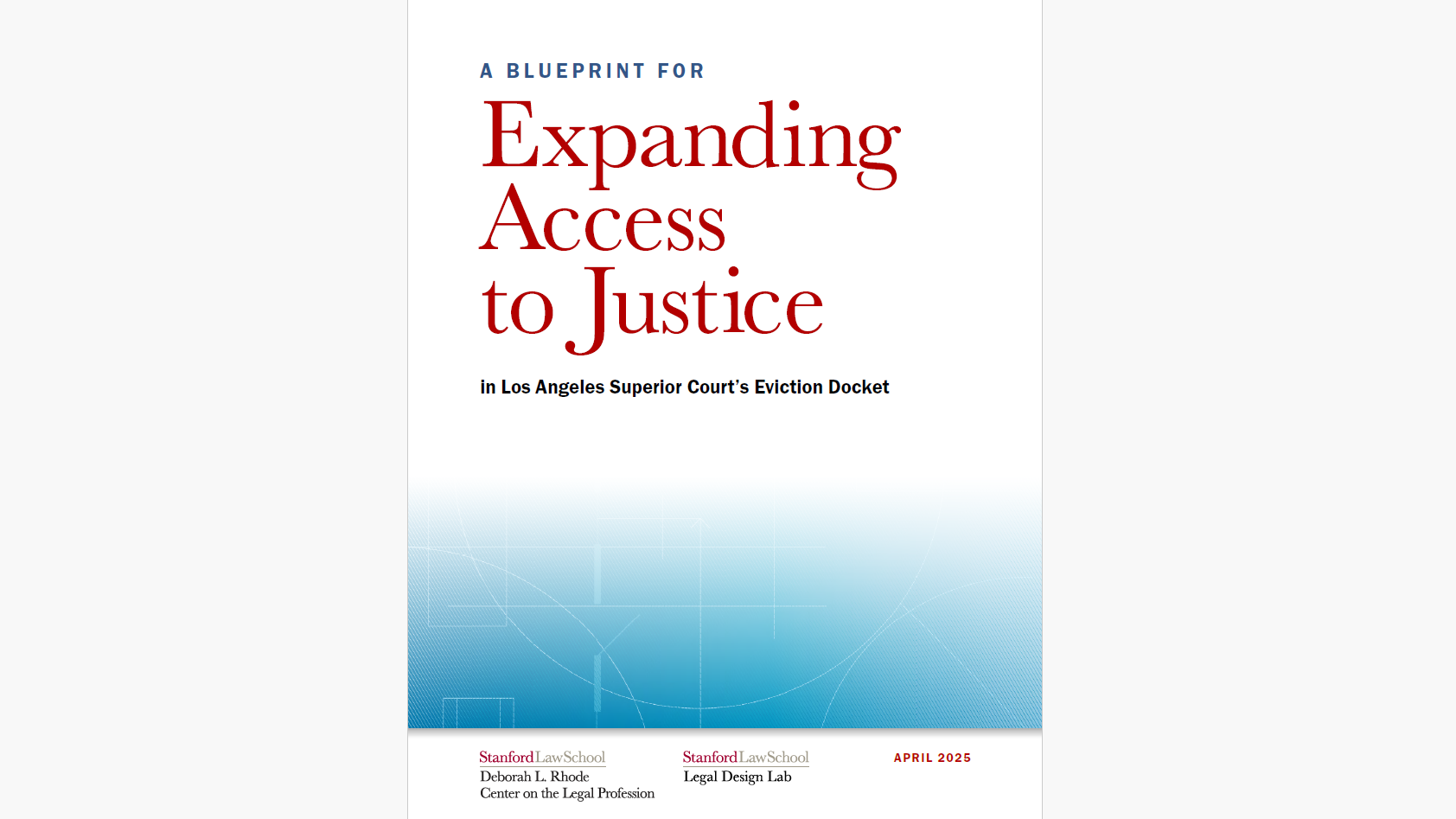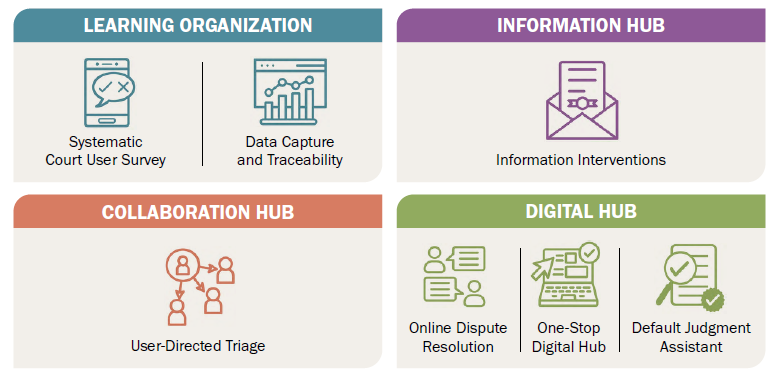In a newly released report with implications for legal technology and access to justice, Stanford Law School’s Deborah L. Rhode Center on the Legal Profession and Legal Design Lab, in partnership with the Superior Court of Los Angeles County (LASC), the largest trial court in the United States, offer a comprehensive analysis of the challenges facing high-volume civil dockets and propose tech-forward solutions to address them.
The report, A Blueprint for Expanding Access to Justice in Los Angeles Superior Court’s Eviction Docket, is based on extensive research by the Stanford team into LASC’s unlawful detainer (eviction) cases. The team analyzed case management data for 150,000 UD filings, conducted more than 100 interviews with court users, hosted focus groups with court staff and legal aid providers, shadowed court users as they navigated court processes, and evaluated the court’s digital tools and web presence.
The researchers documented several concerning trends between 2019 and 2023, including an 11% increase in eviction filings by corporate landlords, a widening representation gap between landlords and tenants, and declining answer rates among tenants. By 2023, nearly 92% of landlords had legal representation compared to only about 14% of tenants.
The report identified significant technological barriers hampering court access. LASC’s websites and digital tools struggle with discoverability, with court websites appearing in less than 0.3% of Google search results for legal help queries. The court currently hosts three competing self-help websites that lack integration with each other and with essential digital tools such as document assembly platforms, e-filing systems, and case-lookup resources.
Another technical shortcoming involves the court’s Online Dispute Resolution (ODR) platform. Despite being launched in 2021, the ODR system was used by both parties in only about 1% of UD cases, with only five cases settling via the platform over a two-year period.
“Serving a population of over 10 million residents, the court is uniquely positioned to drive innovation and change by benchmarking ways to make the judiciary more accessible to those seeking justice,” said David W. Slayton, LASC executive officer and clerk of court. “Thanks in part to the court’s unique partnership with Stanford Law, we now have an actionable blueprint that will guide Court leadership’s decision making going forward.
Four-Pronged Blueprint for Digital Transformation
While the report finds LASC remains a leader in innovation among U.S. courts, there are also a number of opportunities for improvement.
“A lack of meaningful participation among self-represented litigants remains a persistent problem,” the report says. “And, despite significant efforts to partner with service providers, LASC staff struggle to effectively refer court users to third-party legal service providers and do not systematically collect information that is critical for improvements.”
Based on these findings, the report outlines four “frontiers of justice innovation” where technological solutions play a central role:
1. LASC as a Learning Organization
The report calls for LASC to become a true “learning organization” to better understand its own operations and better serve its users. The report recommends it do this by enhancing its data and data-analytics capacity through two key technological initiatives:
- First, implementing systematic court user surveys via text message at critical case junctures to gain insights about user experiences. This would require a general order mandating that plaintiffs provide defendants’ contact information at filing.
- Second, automating data capture from court documents such as complaints, answers and judgments. This would extract key metrics such as reason for eviction, amount in controversy, defenses raised, and case outcomes. The report also recommends tracking users across services through a unique court ID or other digital tracking methods.
2. LASC as an Information Hub
Finding that the court can become a “trusted information hub” for court users, the report identifies significant information barriers that currently exist. Among them, it proposes redesigning the court’s Notice of Unlawful Detainer form (LASC CIV 002) to make critical information more accessible. The redesigned notice would leverage behavioral design principles to make deadlines salient and avoid common misconceptions.
Beyond the physical notice, the researchers recommend supplementing paper notices with digital communications via email and text to reach users through multiple channels. They also propose developing targeted notices for specific jurisdictions and language groups, using data to personalize information delivery.
3. LASC as a Collaboration Hub
To enhance the court’s collaborative relationships with other stakeholders in Los Angeles County, the report recommends developing a user-directed informational triage tool hosted on the court’s website. This technological solution would help litigants self-sort into appropriate legal assistance resources based on their case details, needs and preferences.
“This tool will alleviate the requests for referrals that have become a particular pain point for court staff without involving the court in non-neutral steps that are beyond the court’s purview,” the report says.
The tool would have two components: a chat interface for users and a comprehensive back-end database of service providers. It would elicit information across four categories: case information, demographic eligibility details, capacity details and user preferences. This data would then match users with appropriate services.
4. LASC as a Digital Hub
The most ambitious technological recommendations involve the development of three cutting-edge digital tools to better serve court users:
- First, a revamped ODR platform with improved awareness materials, better usability, and more human support options like mediator availability and phone or video channels.
- Second, an AI-powered Default Judgment Assistant that would enhance and automate the court’s default judgment review process, increasing accuracy and reducing administrative burden. This tool would check case documents against statutory requirements, verify procedural compliance, and flag potential issues for court staff.
- Third, an AI-powered “one-stop hub” that would unify the court’s digital ecosystem into a coordinated interface. This comprehensive platform would support end-to-end user journeys, offering integrated access to form-filing tools, case lookup features, document assembly resources, e-filing services, and case sealing tools. The report suggests this hub could incorporate generative AI and machine learning to enhance user experiences.
“Ultimately, the court could provide a one-stop hub where court users can enter a plain-language description of a civil legal problem or task in a pending case — either directly or in answer to specific questions — and receive actionable, trustworthy information about necessary steps,” the report says.
A Blueprint for Change
The report notes that the court already has a long history of innovation, having pioneered self-help centers, standardized forms, and group-based educational workshops in the 1990s. More recently, LASC has developed digital tools like “Gina,” a traffic court chatbot serving up to 4,000 users weekly, and has begun work on “CourtHelp,” a conversational AI website.
But, despite these innovations, the court faces both continuing challenges and new ones.
“Today, LASC, along with courts across the country, must confront a critical issue: the rising tide of small-scale but high-stakes cases that have come to dominate state civil court dockets, including debt collections, evictions, home foreclosures, and certain family law matters,” the report says.
“This report is more than just a diagnosis; it is a blueprint for change,” said David Freeman Engstrom, professor and co-director of Stanford’s Rhode Center. “While courts everywhere face daunting challenges with high-volume civil dockets, the Superior Court of Los Angeles County’s visionary leadership and willingness to innovate, when combined with Stanford’s deep technical expertise, promises to develop new approaches that work.”
Through this report and their partnership, Stanford and LASC hope not only to improve services in Los Angeles County, but to provide a template for digital transformation of courts nationwide.
“By conducting diagnostic activities, engaging stakeholders, and partnering with researchers, courts nationwide can identify areas for improvement and implement data-driven, human-centered solutions,” the two organizations say.
“With courts around the country facing many common challenges, the fruits of the Superior Court of Los Angeles County-Stanford partnership will benefit court users and communities in Los Angeles and well beyond.”
For those interested in learning more about the study, Stanford and LASC are hosting two webinars in the coming weeks:
- An L.A.-focused webinar on April 30 at 4 p.m. PST. This discussion will focus on the report’s empirical findings about eviction in Los Angeles and on its proposed local solutions. The Stanford and LASC teams say they are especially eager to invite legal aid providers, court staff and other local stakeholders who helped to facilitate the research underlying this report.
- A national webinar on May 1 at 1:30 p.m. PST. This discussion will center the SCLAC-Stanford partnership in the national context of court modernization and reform. The Stanford and SCLAC teams say they are especially eager to invite court leaders, academics, policymakers, and other justice stakeholders.
 Robert Ambrogi Blog
Robert Ambrogi Blog
